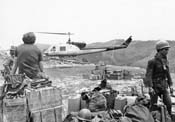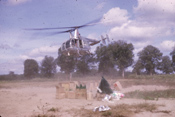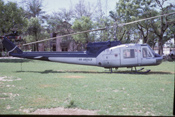Vietnam: The Helicopter War
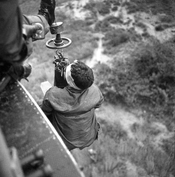
In a secured area on the outskirts of Saigon, medics and members of an Aviation Medical Evacuation Unit practice airlifting a soldier from the ground, up into a Huey using a cable hoist, and then fly to a local medical facility. Speed and technique were graded and all concerned received a thumbs-up. Photo by Robert C. Lafoon US Army Sp Photo Det, Pacific
Robert Lafoon Collection Department of the Army Special Photographic Office (DASPO) [VA029718]

Evacuation of the Plain of Jars, Laos 1969
Daniel L. Williams Collection Air America Association [VA050365]
Search and Rescue, POWs, and Air America
One of the constant challenges facing U.S. forces in Vietnam was the risk of being captured and taken prisoner of war (POW). This was especially the case for aviators and flight crews who were at risk of being shot down over enemy territory with no ground support to protect them. In addition to facing this challenge when flying missions over both North and South Vietnam, the flight paths and bombing routes used would often take pilots over Laos where communist forces on the ground posed a very serious risk to downed airmen. They could also crash in the South China Sea where the vastness of the open ocean might prevent their rescue. If a U.S. aircraft was shot down, it was essential to crew survival that they be picked up as quickly as possible. The helicopter proved essential in accomplishing that mission.
Search and Rescue, or SAR, operations played a vital role in minimizing the number of airmen and flight crews captured or killed when their aircraft were shot down. Unfortunately, the technology needed to conduct effective SAR operations took time to develop and refine. In the early 1960s, the primary aircraft used for SAR missions, the Kaman H-43, was limited by its very short fuel range of only 75 miles. In addition, the inability of the rescue aircraft to penetrate the dense jungle canopy of Vietnam and Laos prevented many rescues. This problem was addressed in 1965 with the invention of the "jungle penetrator," a heavy steel probe attached to a rescue harness that could penetrate the dense jungle foliage and reach a person on the ground. The introduction of better rescue aircraft also occurred in 1965 with the Sikorsky CH-3 (the initial "Jolly Green Giant" which later included the HH-3 and HH-53). The "Jolly Greens" all had better fuel range and flying capabilities, allowing them to fly deep into enemy territory to rescue downed aircrews.
The civilian organization Air America was another important partner in rescuing downed U.S. pilots and aircrews. Operating in Vietnam, Laos, and Thailand, Air America had one of the largest fleets of aircraft in the world and included both rotary- and fixed-wing aircraft. While they fronted as a private corporation, they were technically owned and operated by the CIA and flew contract missions throughout the war, mostly in support of the Secret War in Laos. As Air America pilots flew over Laos, they monitored the military radio frequencies and, upon learning of a downed U.S. aircraft, would attempt to rescue the American crew. Between 1964 and 1973, Air America rescued scores of U.S. pilots, living up to their motto of "Anything, Anywhere, Anytime, Professionally."
Combined, U.S. SAR operations during the Vietnam War saved the lives of nearly 4,000 American pilots and crew members.
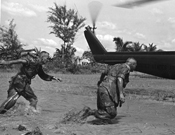
Col John P. Geraci, 9th Inf Div, 1st Bde Cdr, and CPT Robert Kayzer, Bde Asst Intel Off, dash for a rescue ship after enemy shot down the C&C helo.
Claire Starnes Collection Vietnam Women Veterans Association [VA053670]
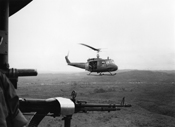
Picture taken from a helicopter of another helicopter flying.
Claire Starnes Collection Vietnam Women Veterans Association [VA053674]
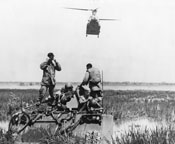
The 242nd Assault Support Helicopter Company (Muleskinners), makes a tank rescue in Vietnam.
U.S. Army Aviation Museum Volunteer Archivists Collection [VA059047]
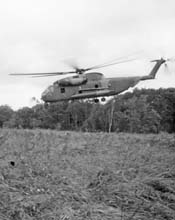
USAF (United States Air Force) CH-53 Super Stallion Helicopter, Jolly Greens, used to augment Air America (AAM) if large numbers of troops needed to be moved.
Michael Ingham Collection [VA061010]
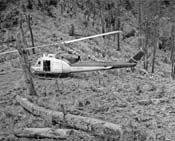
Looking for identifying numbers on USAF aircraft wreckage in effort to assist MIA aircrew search. F105 crash sight on Plaines De Jarres (PDJ)
Michael Ingham Collection [VA061049]
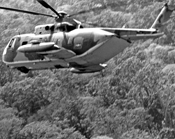
An Air Force HH-3C rescue helicopter searches for a downed fighter pilot in the jungles of Vietnam.
George H. Kelling Collection [VA061450]
Bibliography
- 3670816009, George J. Veith Collection, The Vietnam Center and Sam Johnson Vietnam Archive, Texas Tech University.
- 1517AU1609, James M. Hall, Jr. Collection, The Vietnam Center and Sam Johnson Vietnam Archive, Texas Tech University.
- VA029718, Robert Lafoon Collection, The Vietnam Center and Sam Johnson Vietnam Archive, Texas Tech University.
- VA050365, Daniel L. Williams Collection, The Vietnam Center and Sam Johnson Vietnam Archive, Texas Tech University.
- VA053670, Claire Starnes Collection, The Vietnam Center and Sam Johnson Vietnam Archive, Texas Tech University.
- VA053674, Claire Starnes Collection, The Vietnam Center and Sam Johnson Vietnam Archive, Texas Tech University.
- VA059047, U.S. Army Aviation Museum Volunteer Archivists Collection, The Vietnam Center and Sam Johnson Vietnam Archive, Texas Tech University.
- VA060857, Michael Ingham Collection, The Vietnam Center and Sam Johnson Vietnam Archive, Texas Tech University.
- VA061010, Michael Ingham Collection, The Vietnam Center and Sam Johnson Vietnam Archive, Texas Tech University.
- VA061049, Michael Ingham Collection, The Vietnam Center and Sam Johnson Vietnam Archive, Texas Tech University.
- VA061450, George H. Kelling Collection, The Vietnam Center and Sam Johnson Vietnam Archive, Texas Tech University.
- VAS005004, Calvin Chapman Collection, The Vietnam Center and Sam Johnson Vietnam Archive, Texas Tech University.
- VAS008718, Curtis Knapp Collection, The Vietnam Center and Sam Johnson Vietnam Archive, Texas Tech University.
Vietnam Center & Sam Johnson Vietnam Archive
-
Address
Texas Tech University, Box 41041, Lubbock, TX 79409 -
Phone
(806)742-9010 -
Email
vnca@ttu.edu


